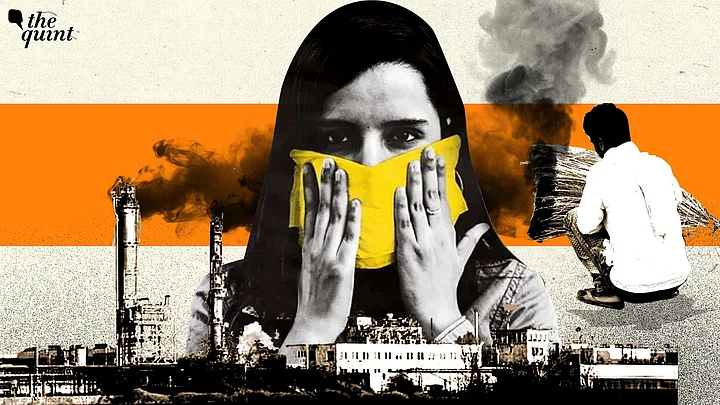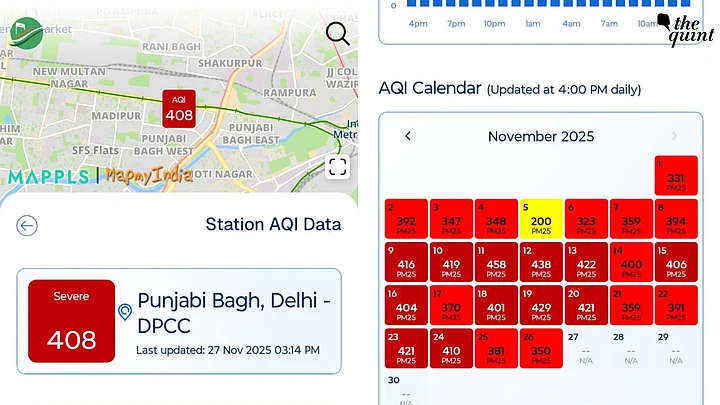"Parents are more confused and angrier than ever," environmentalist Bhavreen Kandhari tells The Quint, a day after the Centre’s Commission for Air Quality Management (CAQM) revoked the stringent Stage III restrictions under the Graded Response Action Plan (GRAP) across Delhi.
"Parents have spent weeks seeking advisory to restrict outdoor activity to protect their children. Closing schools damaged their learning, but reopening or shifting rules without clarity has disrupted their lives and reopened the risk for health and pollution exposure," adds Kandhari, who's the co-founder of WarriorMoms, a collective of Indian mothers demanding clean air for children.
GRAP, which was first introduced in 2017, is a graded and pre-determined emergency response mechanism based on AQI levels of Delhi.
But experts point out limitations in the system itself, including the averaging of daily AQI data across the National Capital Region (NCR), that can "cause more harm" at a time when the air quality continues to remain in the 'very poor' category.
Limitation 1: Pollution Averaged Out
Each stage under GRAP corresponds directly to a pollution range. Stage III restrictions are imposed when the air quality dips to "severe"—with AQI levels ranging from 401 to 450.
The CAQM on Wednesday, 26 November said the daily average AQI levels in Delhi NCR had witnessed "a steady improvement", holding below 400 in the ‘very poor’ range for an entire week.
According to a press release by the Ministry of Environment, Forest and Climate Change, Delhi's daily average AQI has been "showing a downward trend" with the AQI level at 391 on 23 November, 382 on 24 November, 353 on 25 November, and 327 on 26 November.
But as these numbers are averaged across 142 monitoring stations across Delhi NCR, they bring down the average, masking pockets of Delhi where air quality remains firmly in the ‘severe’ zone. This is evident in CAQM’s own AQI data.
For instance, Nehru Nagar, Chandni Chowk, Anand Vihar, and Punjabi Bagh recorded 400+ AQI level at least one day between 23 November and 26 November.
Meanwhile, Sector 30, Faridabad, which falls within the National Capital Region (NCR), has consistently recorded AQI levels under 250 the past four days, affecting the average.
"This leads to certain areas having more polluted air, but not having measures and restrictions in place corresponding to the air quality there," Sunil Dahiya, Founder and Lead Analyst at Envirocatalysts, tells The Quint.
"A threshold closer to 350 would better account for densely populated localities that mostly experience AQI levels above 400. Such concentrations remain hazardous and merit urgent attention," adds Dr Nitish Dogra, a public health physician and Fulbright Fellow working for the Pahle India Foundation.
(The Quint has sought a response from the CAQM and the Environment Ministry regarding potential issues with relying on an average AQI for the entire Delhi-NCR region. We will update this story as and when they respond.)
Limitation 2: A False Sense of Security
GRAP simply means that the air quality has been graded, and therefore, the actions that must follow have been graded too. Like Stage III restrictions, Stage I is enforced when the AQI ranges between 201 and 300; and Stage II when the range is from 301 to 400. Similarly, Stage IV is enforced when the AQI levels cross 450.
“Invoking or lifting any GRAP measure isn’t a matter of deliberation or discretion. The framework is designed to trigger actions automatically based on the AQI,” Dahiya tells The Quint.
This, in itself, is a flawed system, say experts, because apart from the daily average AQI not taking into account the pollution hotspots, and therefore, no tailored action or response to the real-time pollution levels there, it gives a false sense of security.
With the rollback of GRAP III, apart from the reopening of schools, offices are no longer obligated to implement work-from-home arrangements for 50 percent employees, across Delhi NCR.
Older diesel vehicles will also be allowed on roads again, "which means emissions will again increase and there is a high likelihood that, if the meterological conditions don't improve, we will again slip into the 'severe' zone needing GRAP III stage to be invoked again," Dahiya adds.
"Right now the average AQI may have come below 350 (‘very poor’), but it might go up again tomorrow, so revoking the measures now really doesn't make sense."Sunil Dahiya
As per the Environment Ministry's statement, air quality forecasts indicate the likelihood of the average AQI of Delhi to stay in ‘very poor’ category in the coming days, but experts say this can change. Such fluctuations are especially common in winter, when sudden temperature drops and slower wind patterns affect air quality, they explain.
"The AQI levels in the city will remain high and variable throughout winters. So you might see 'very poor' today, and then 'severe' two days later, and again it can come down to 'poor' if the wind speed improves," Anumita Roychowdary, Executive Director, Research and Advocacy, Centre for Science and Environment, tells The Quint.
Limitation 3: Not a Sign of Safer Air
Dahiya says, "This big show of implementing and recalling GRAP measures only creates the illusion that the government is taking meaningful action."
Other experts say the race for optics can actually do more harm as revoking GRAP III automatically means the air has improved, leading to complacency and lax enforcement.
"Let's not be under the impression that any of these are less harmful or ‘normal’. None of these grades, whether 'severe', 'very poor', or 'poor', are healthy nor should they be normalised. All these grades are very harmful... it’s only a degree of difference."Anumita Roychowdhury
"Nowhere should anyone be saying that if you've come down from GRAP III to GRAP II, that the air has 'improved', and so the danger is averted. This should be made clear to people. There should be no room for complacency," Roychowdhury adds.
Better messaging is needed to drive this point home. At the same time, it must be emphasised that strict restrictions on high-polluting activities listed under GRAP I and II are meant to continue being enforced even if GRAP III has been revoked.
"But we all know that what’s written on paper and what actually happens in reality are often worlds apart," says Dahiya, adding,
“Even under the current GRAP framework, there is no strict action taken against industrial polluters, which are a major source, and violations are seldom punished."
GRAP Only a Temporary Measure to a Permanent Problem
According to the Environment Ministry, the decision to revoke GRAP III was taken in part, "keeping in view the disruptive nature of restrictions... impacting a large number of stakeholders and public."
This is always a difficult decision to make, says Anumita Roychowdhury. "Air pollution is a constant issue in Delhi. To what extent can you shut down the economy and to what extend can you shut down the city? And for how long?"
GRAP is only an emergency response to reduce exposure once the air quality has already deteriorated and to help prevent worsening, experts reiterate, adding it is "futile without long-term, year-round action".
"The entire focus of the framework is reacting when the pollution level reaches a certain stage, and most of the measures seem to be very people-centric, while the sources of pollution, which are more systemic and institutional, remain largely unaddressed," says Dahiya.
Roychowdhury agrees, adding, "Clearly this is the time when we have to think about reducing population-wide exposure in whatever way possible through community action and through mandatory legal action, but the fundamental issue is that you have to reduce pollution at its source, and there is no way around it because otherwise year after year you will find yourself in this position.”
"This is why we have been emphasising again and again that instead of focus only on winter pollution, we really need very stringent focus on round-the-year action to permanently reduce emission from sources. There really is no way out."Anumita Roychowdhury




